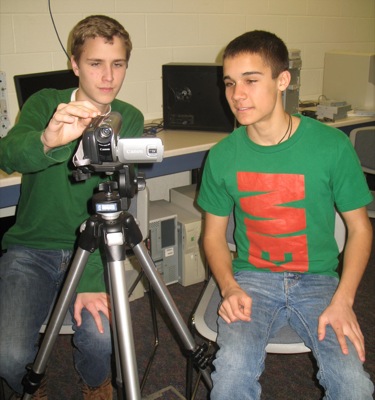Tuesday, March 10th, 2009
Preserving history
Minster students use camera to capture veterans' memories
By Margie Wuebker

Photo by Margie Wuebker/The Daily Standard
Minster High School sophomores David Slonkosky, left, and Oliver Barga check out the video camera before proceeding with an oral history project involving a dozen local World War II veterans. Teacher Austin Kaylor's world history class and the Minster Historical Society are collaborating on the effort.
MINSTER - George Brown takes a seat in a makeshift recording studio at Minster High School and begins talking about his experiences during the World War II era.
He is one of 12 area veterans sharing such memories as part of an oral history project sponsored by the Minster Historical Society in cooperation with teacher Austin Kaylor's sophomore world history class.
Students David Slonkosky and Oliver Barga interview Brown - their great-uncle - as the camera rolls. At the age of 18, he boarded a school bus in Wapakoneta bound for Fort Hayes near Columbus. Five hundred men reported for physical exams that day with the field broken down in more manageable groups of 150.
"We were buck naked and that was quite a sight," Brown says with a chuckle. "We spent a whole day visiting various stations. I can still remember the sight of all our clothes hanging from pegs along the wall."
Recruits went to Camp Atterbury, Ind., and then to one of five Army camps in Livingston, La. Townspeople erected signs warning dogs and soldiers to stay off the grass.
"I never took part in any fighting but our instructors were hardened men who had returned from Europe," he said. "They taught us to be infantrymen and to kill rather than to be killed."
Soldiers logged hours in bayonet training, driving spears into straw dummies. Many also qualified for sharpshooter status at the rifle range.
Brown later went to Japan as part of the Army's Fourth Replacement Depot staff. His duties included guarding "some of the big dogs" at military headquarters.
The students' interview of Brown will become part of a video to be displayed at the town's historical museum from May 20 to June 20 as part of Salute To Our Military Month.
It was historical society member Mary Oldiges who contacted building principals about the project and provided names of veterans. Students then drafted the questions and conducted the interviews and tapings.
"America is losing World War II soldiers and sailors by the thousands," says Kaylor, whose sophomore students were chosen for the project because they already studied the war. "Those who remain provide a wealth of information if we just take the time to listen. Hopefully, future efforts will focus on Korean and Vietnam veterans."
Also on the video is Fred Boecker, a former U.S. Army infantryman who came to his taping carrying a Japanese sword he brought home from the battlefield nearly six decades ago.
"It was like history unfolding before our eyes," sophomore Jacob Goodwin says. "Fred saw a lot of action involving the Japanese. The amount of stuff he remembers is amazing. I guess there are some things you never forget like being on the front line or walking into a ambush."
Military officials awarded Boecker the Bronze Medal recognizing his heroism and service to others. A strong man at the time, he carried wounded comrades to protected sites.
"I was amazed at the sacrifices he made for others," student Chase Paxson says. "He didn't have to put himself at risk but he did so that others might live."
Kaylor believes the assignment has given students a hands-on appreciation for history. World War II is no longer something they read in a textbook; it is something they experienced through the eyes of local residents.
"Quizzes and tests are wonderful tools for gauging student comprehension," the teacher says. "Something like this comes along and I have an opportunity to see the kids' reaction to hands-on learning. What they heard during the interviews will stay with them long after our part of the project is completed."
